Modeling and Optimization of a Compression Ignition Engine Fueled with Biodiesel Blends for Performance Improvement
Abstract
:1. Introduction
1.1. A Literature Review of Biodiesel Engine Performance
1.2. Literature Review on Engine Performance Optimization Approaches
1.3. Research Gap, Objectives, and Originality
1.4. Manuscript Organization
2. Experimental Setup, Equipment, Procedure, Modeling, and Optimization
2.1. Biodiesel Preparation
2.2. Engine Performance Measurements
2.3. Modeling and Optimization
3. Results and Discussion
3.1. Engine Performance Analysis
3.1.1. Engine Brake Torque (BT) and Brake Power (BP)
3.1.2. Brake Specific Fuel Consumption (BSFC)
3.1.3. Brake Thermal Efficiency (BTE)
3.2. Uncertainty Analysis
3.3. Modeling and Optimization
3.3.1. Fuzzy-Based Modeling Logic
3.3.2. Parameter Optimization
3.3.3. Response Surface Methodology (RSM)
3.3.4. Optimization-Based Response Surface Methodology (RSM)
3.4. Comparison Study
4. Conclusions
- When compared to pure diesel, all biodiesel blends boost brake power. Because of its slightly higher calorific value and higher oxygen content, palm biodiesel offers the highest brake power increase of 8.7%, compared to other biodiesel blends.
- On average, there is a reduction in BTE of 6.7%, 4.4%, and 2.4% for palm, sunflower, and corn biodiesels, respectively, as compared to pure diesel. For all the biodiesel blends, BSFC increases, while heating value decreases. However, in this case, the increase in brake-specific fuel consumption is more significant. This explains why biodiesel blends have a poorer BTE, despite their low heating value. Furthermore, biodiesel mixes have a shorter ignition delay than pure diesel, implying that combustion starts sooner. More heat is lost to the atmosphere, as a result of the shorter ignition delay, necessitating more power for the piston to perform the compression stroke.
- Palm, sunflower, and corn biodiesels had an average increase in BSFC of 7.4%, 4.9%, and 2.5%, respectively, compared to pure diesel. Because biodiesel blends have a lower calorific value than pure diesel, they consume more fuel to provide the same braking power output.
- Palm biodiesel has the highest kinematic viscosity, resulting in poor fuel atomization and mixture formation, as well as a larger BSFC rise than the other test fuels.
- The physical and chemical characteristics of biodiesel blends, such as oxygen content, cetane number, calorific value, kinematic viscosity, and latent heat of vaporization have a direct impact on combustion efficiency.
- The average R2 value, utilizing a fuzzy-based model, has been increased by 27.7% and 29.3%, for training and testing, respectively, as compared to ANOVA.
- Based on the optimization process using PSO, the optimal engine speed is 1648 rpm, and the best fuel is sunflower oil.
- Using the proposed strategy (integration between fuzzy logic and PSO), the overall performance has been increased by 2.065% and 8.256%, as compared to the experimental results and RSM.
Author Contributions
Funding
Institutional Review Board Statement
Informed Consent Statement
Acknowledgments
Conflicts of Interest
Nomenclatures
| AI | artificial intelligence |
| ANFIS | adaptive network-based fuzzy inference system |
| ANN | artificial neural network |
| ANOVA | analysis of variance |
| ASTM | American Society for Testing and Materials |
| B0, Bi, Bii, and Bij | regression coefficients |
| BP | brake power |
| BSFC | brake specific fuel consumption |
| BT | brake torque |
| BTDC | before top dead center |
| BTE | brake thermal efficiency |
| c1, c2 | a cognitive and social factor |
| CFPP | cold filter plugging point |
| CN | cetane number |
| CO | carbon monoxide |
| DC | direct current |
| F | fuel type |
| FS | full scale |
| FSD | full scale deflection |
| FTIR | Fourier-transform infrared spectroscopy |
| gbest | the global best |
| K | number of factors |
| M | mean of the gaussian curve |
| MF | fuzzy membership function of the input |
| MSE | mean square error |
| N | rotation engine speed |
| NOx | nitrogen oxides |
| NREL | national renewable energy laboratory |
| Pbest | best solution |
| PSO | particle swarm optimization |
| R | outcome function |
| r | random value |
| RMS | root mean square |
| RMSE | root mean square error |
| rpm | revolution per minute |
| RSM | response surface methodology |
| RTD | resistance temperature detectors |
| R2 | coefficient of determination |
| S | speed |
| SFC | specific fuel consumption |
| TBHQ | tert-butylhydroquinone |
| V | velocity |
| vol. | volume |
| WR | uncertainty error |
| Wt. | weight |
| x | Variable, factors |
| Y | predicted output response |
| ω | realistic error |
| σ | spread of the curve |
References
- Chaichan, M.T. Performance and Emission Characteristics of CIE Using Hydrogen, Biodiesel, and Massive EGR. Int. J. Hydrogen Energy 2018, 43, 5415–5435. [Google Scholar] [CrossRef]
- Aladayleh, W.; Alahmer, A. Recovery of Exhaust Waste Heat for ICE Using the Beta Type Stirling Engine. J. Energy 2015, 1–8. [Google Scholar] [CrossRef] [Green Version]
- Alahmer, A.I.; Adaileh, W.M.; Al Zubi, M.A. Monitoring of a Spark Ignition Engine Malfunctions Using Acoustic Signal Technique. Int. J. Veh. Noise Vib. 2014, 10, 201–213. [Google Scholar] [CrossRef]
- Zacharczuk, W.; Andruszkiewicz, A.; Tatarek, A.; Alahmer, A.; Alsaqoor, S. Effect of Ca-Based Additives on the Capture of SO2 during Combustion of Pulverized Lignite. Energy 2021, 231, 120988. [Google Scholar] [CrossRef]
- Gomaa, M.R.; Al-Dmour, N.; AL-Rawashdeh, H.A.; Shalby, M. Theoretical Model of a Fluidized Bed Solar Reactor Design with the Aid of MCRT Method and Synthesis Gas Production. Renew. Energy 2020, 148, 91–102. [Google Scholar] [CrossRef]
- Borowski, G.; Alsaqoor, S.; Alahmer, A. Using Agglomeration Techniques for Coal and Ash Waste Management in the Circular Economy. Adv. Sci. Technol. Res. J. 2021, 15, 264–276. [Google Scholar] [CrossRef]
- Taghizadeh-Alisaraei, A.; Ghobadian, B.; Tavakoli-Hashjin, T.; Mohtasebi, S.S. Vibration Analysis of a Diesel Engine Using Biodiesel and Petrodiesel Fuel Blends. Fuel 2012, 102, 414–422. [Google Scholar] [CrossRef]
- Dal, H.; Emiroğlu, A.O.; Bilge, H.; Şen, M. Experimental Investigation of the Effects of Chicken and Turkey Biodiesel Blends on Diesel Engine Noise Emissions. Int. J. Environ. Sci. Technol. 2019, 16, 5147–5154. [Google Scholar] [CrossRef]
- Alahmer, A. Reduction a Particulate Matter of Diesel Emission by the Use of Several Oxygenated Diesel Blend Fuels. Int. J. Therm. Environ. Eng. 2014, 7, 45–50. [Google Scholar]
- Gomaa, M.R.; Mustafa, R.J.; Al-Dmour, N. Solar Thermochemical Conversion of Carbonaceous Materials into Syngas by Co-Gasification. J. Clean. Prod. 2020, 248, 119185. [Google Scholar] [CrossRef]
- Dey, S.; Deb, M.; Das, P.K. An Investigation of Diesohol-Biodiesel Mixture in Performance-Emission Characteristics of a Single Cylinder Diesel Engine: A Trade-off Benchmark. Int. J. Automot. Mech. Eng. 2019, 16, 7464–7479. [Google Scholar] [CrossRef] [Green Version]
- Bae, C.; Kim, J. Alternative Fuels for Internal Combustion Engines. Proc. Combust. Inst. 2017, 36, 3389–3413. [Google Scholar] [CrossRef]
- Hasan, A.O.; Osman, A.I.; Ala’a, H.; Al-Rawashdeh, H.; Abu-jrai, A.; Ahmad, R.; Gomaa, M.R.; Deka, T.J.; Rooney, D.W. An Experimental Study of Engine Characteristics and Tailpipe Emissions from Modern DI Diesel Engine Fuelled with Methanol/Diesel Blends. Fuel Process. Technol. 2021, 220, 106901. [Google Scholar] [CrossRef]
- Reang, N.M.; Dey, S.; Deb, M.; Deb Barma, J. Effect of Diesel-biodiesel-alcohol Blends on Combustion, Performance, and Emission Characteristics of a Single Cylinder Compression Ignition Engine. Environ. Prog. Sustain. Energy 2021, e13752. [Google Scholar] [CrossRef]
- Song, J.T.; Zhang, C.H. An Experimental Study on the Performance and Exhaust Emissions of a Diesel Engine Fuelled with Soybean Oil Methyl Ester. Proc. Inst. Mech. Eng. Part D J. Automob. Eng. 2008, 222, 2487–2496. [Google Scholar] [CrossRef]
- Ramadhas, A.S.; Muraleedharan, C.; Jayaraj, S. Performance and Emission Evaluation of a Diesel Engine Fueled with Methyl Esters of Rubber Seed Oil. Renew. Energy 2005, 30, 1789–1800. [Google Scholar] [CrossRef]
- Pinzi, S.; Garcia, I.L.; Lopez-Gimenez, F.J.; Luque de Castro, M.D.; Dorado, G.; Dorado, M.P. The Ideal Vegetable Oil-Based Biodiesel Composition: A Review of Social, Economical and Technical Implications. Energy Fuels 2009, 23, 2325–2341. [Google Scholar] [CrossRef]
- Labeckas, G.; Slavinskas, S. Comparative Evaluation of the Combustion Process and Emissions of a Diesel Engine Operating on the Cetane Improver 2-Ethylhexyl Nitrate Doped Rapeseed Oil and Aviation JP-8 Fuel. Energy Convers. Manag. X 2021, 11, 100106. [Google Scholar] [CrossRef]
- Graboski, M.S.; McCormick, R.L.; Alleman, T.L.; Herring, A.M. The Effect of Biodiesel Composition on Engine Emissions from a DDC Series 60 Diesel Engine. Natl. Renew. Energy Lab. 2003. Available online: https://www.nrel.gov/docs/fy03osti/31461.pdf (accessed on 25 November 2021).
- Broatch, A.; Tormos, B.; Olmeda, P.; Novella, R. Impact of Biodiesel Fuel on Cold Starting of Automotive Direct Injection Diesel Engines. Energy 2014, 73, 653–660. [Google Scholar] [CrossRef] [Green Version]
- Rakopoulos, D.C.; Rakopoulos, C.D.; Giakoumis, E.G.; Dimaratos, A.M.; Founti, M.A. Comparative Environmental Behavior of Bus Engine Operating on Blends of Diesel Fuel with Four Straight Vegetable Oils of Greek Origin: Sunflower, Cottonseed, Corn and Olive. Fuel 2011, 90, 3439–3446. [Google Scholar] [CrossRef]
- Sureshkumar, K.; Velraj, R.; Ganesan, R. Performance and Exhaust Emission Characteristics of a CI Engine Fueled with Pongamia Pinnata Methyl Ester (PPME) and Its Blends with Diesel. Renew. Energy 2008, 33, 2294–2302. [Google Scholar] [CrossRef]
- Rakopoulos, C.D.; Antonopoulos, K.A.; Rakopoulos, D.C.; Hountalas, D.T.; Giakoumis, E.G. Comparative Performance and Emissions Study of a Direct Injection Diesel Engine Using Blends of Diesel Fuel with Vegetable Oils or Bio-Diesels of Various Origins. Energy Convers. Manag. 2006, 47, 3272–3287. [Google Scholar] [CrossRef]
- Atmanlı, A.; Ileri, E.; Yüksel, B. Experimental Investigation of Engine Performance and Exhaust Emissions of a Diesel Engine Fueled with Diesel–n-Butanol–Vegetable Oil Blends. Energy Convers. Manag. 2014, 81, 312–321. [Google Scholar] [CrossRef]
- Chacko, N.; Jeyaseelan, T. Comparative Evaluation of Graphene Oxide and Graphene Nanoplatelets as Fuel Additives on the Combustion and Emission Characteristics of a Diesel Engine Fuelled with Diesel and Biodiesel Blend. Fuel Process. Technol. 2020, 204, 106406. [Google Scholar] [CrossRef]
- Gad, M.S.; Jayaraj, S. A Comparative Study on the Effect of Nano-Additives on the Performance and Emissions of a Diesel Engine Run on Jatropha Biodiesel. Fuel 2020, 267, 117168. [Google Scholar] [CrossRef]
- Rajak, U.; Chaurasiya, P.K.; Nashine, P.; Verma, M.; Kota, T.R.; Verma, T.N. Financial Assessment, Performance and Emission Analysis of Moringa Oleifera and Jatropha Curcas Methyl Ester Fuel Blends in a Single-Cylinder Diesel Engine. Energy Convers. Manag. 2020, 224, 113362. [Google Scholar] [CrossRef]
- Tasca, A.L.; di Capaci, R.B.; Tognotti, L.; Puccini, M. Biomethane from Short Rotation Forestry and Microalgal Open Ponds: System Modeling and Life Cycle Assessment. Bioresour. Technol. 2019, 273, 468–477. [Google Scholar] [CrossRef]
- Dey, S.; Reang, N.M.; Das, P.K.; Deb, M. A Comprehensive Study on Prospects of Economy, Environment, and Efficiency of Palm Oil Biodiesel as a Renewable Fuel. J. Clean. Prod. 2021, 286, 124981. [Google Scholar] [CrossRef]
- Yee, K.F.; Tan, K.T.; Abdullah, A.Z.; Lee, K.T. Life Cycle Assessment of Palm Biodiesel: Revealing Facts and Benefits for Sustainability. Appl. Energy 2009, 86, S189–S196. [Google Scholar] [CrossRef]
- Jiaqiang, E.; Liu, T.; Yang, W.M.; Li, J.; Gong, J.; Deng, Y. Effects of Fatty Acid Methyl Esters Proportion on Combustion and Emission Characteristics of a Biodiesel Fueled Diesel Engine. Energy Convers. Manag. 2016, 117, 410–419. [Google Scholar]
- Boudy, F.; Seers, P. Impact of Physical Properties of Biodiesel on the Injection Process in a Common-Rail Direct Injection System. Energy Convers. Manag. 2009, 50, 2905–2912. [Google Scholar] [CrossRef]
- Erdoğan, S.; Aydın, S.; Balki, M.K.; Sayin, C. Operational Evaluation of Thermal Barrier Coated Diesel Engine Fueled with Biodiesel/Diesel Blend by Using MCDM Method Base on Engine Performance, Emission and Combustion Characteristics. Renew. Energy 2020, 151, 698–706. [Google Scholar] [CrossRef]
- Patel, C.; Tiwari, N.; Agarwal, A.K. Experimental Investigations of Soyabean and Rapeseed SVO and Biodiesels on Engine Noise, Vibrations, and Engine Characteristics. Fuel 2019, 238, 86–97. [Google Scholar] [CrossRef]
- Krishania, N.; Rajak, U.; Chaurasiya, P.K.; Singh, T.S.; Birru, A.K.; Verma, T.N. Investigations of Spirulina, Waste Cooking and Animal Fats Blended Biodiesel Fuel on Auto-Ignition Diesel Engine Performance, Emission Characteristics. Fuel 2020, 276, 118123. [Google Scholar] [CrossRef]
- Singh, T.S.; Verma, T.N. Analysis of the Effect of Temperature on the Morphology of Egg Shell Calcium Oxide Catalyst: Catalyst Production for Biodiesel Preparation. Sci. Iran. 2020, 27, 2915–2923. [Google Scholar]
- Nalgundwar, A.; Paul, B.; Sharma, S.K. Comparison of Performance and Emissions Characteristics of DI CI Engine Fueled with Dual Biodiesel Blends of Palm and Jatropha. Fuel 2016, 173, 172–179. [Google Scholar] [CrossRef]
- Sanjid, A.; Masjuki, H.H.; Kalam, M.A.; Abedin, M.J.; Rahman, S.M.A. Experimental Investigation of Mustard Biodiesel Blend Properties, Performance, Exhaust Emission and Noise in an Unmodified Diesel Engine. APCBEE Procedia 2014, 10, 149–153. [Google Scholar] [CrossRef] [Green Version]
- Ndayishimiye, P.; Tazerout, M. Use of Palm Oil-Based Biofuel in the Internal Combustion Engines: Performance and Emissions Characteristics. Energy 2011, 36, 1790–1796. [Google Scholar] [CrossRef]
- Patel, C.; Agarwal, A.K.; Tiwari, N.; Lee, S.; Lee, C.S.; Park, S. Combustion, Noise, Vibrations and Spray Characterization for Karanja Biodiesel Fuelled Engine. Appl. Therm. Eng. 2016, 106, 506–517. [Google Scholar] [CrossRef]
- Bhowmik, S.; Panua, R.; Ghosh, S.K.; Paul, A.; Debroy, D. Prediction of Performance and Exhaust Emissions of Diesel Engine Fuelled with Adulterated Diesel: An Artificial Neural Network Assisted Fuzzy-Based Topology Optimization. Energy Environ. 2018, 29, 1413–1437. [Google Scholar] [CrossRef]
- Alahmer, A.; Ajib, S. Solar Cooling Technologies: State of Art and Perspectives. Energy Convers. Manag. 2020, 214, 112896. [Google Scholar] [CrossRef]
- Rajak, U.; Nashine, P.; Singh, T.S.; Verma, T.N. Numerical Investigation of Performance, Combustion and Emission Characteristics of Various Biofuels. Energy Convers. Manag. 2018, 156, 235–252. [Google Scholar] [CrossRef]
- Dey, S.; Deb, M.; Das, P.K. Application of Fuzzy-Assisted Grey Taguchi Approach for Engine Parameters Optimization on Performance-Emission of a CI Engine. Energy Sources Part A Recover. Util. Environ. Eff. 2019, 1–17. [Google Scholar] [CrossRef]
- Umeuzuegbu, J.C.; Okiy, S.; Nwobi-Okoye, C.C.; Onukwuli, O.D. Computational Modeling and Multi-Objective Optimization of Engine Performance of Biodiesel Made with Castor Oil. Heliyon 2021, 7, e06516. [Google Scholar] [CrossRef] [PubMed]
- Ismail, H.M.; Ng, H.K.; Queck, C.W.; Gan, S. Artificial Neural Networks Modelling of Engine-out Responses for a Light-Duty Diesel Engine Fuelled with Biodiesel Blends. Appl. Energy 2012, 92, 769–777. [Google Scholar] [CrossRef]
- Li, J.; Wu, D.; Attar, H.M.; Xu, H. Geometric Neuro-Fuzzy Transfer Learning for in-Cylinder Pressure Modelling of a Diesel Engine Fuelled with Raw Microalgae Oil. Appl. Energy 2022, 306, 118014. [Google Scholar] [CrossRef]
- Salam, S.; Verma, T.N. An Empirical Investigation on the Influence of Operating Conditions on Internal Combustion Engine Behavior and Their Graded Significance. Energy Sources Part A Recover. Util. Environ. Eff. 2021, 1–19. [Google Scholar] [CrossRef]
- Salam, S.; Verma, T.N. Analysis of Significance of Variables in IC Engine Operation: An Empirical Methodology. Energy Convers. Manag. 2020, 207, 112520. [Google Scholar] [CrossRef]
- Salam, S.; Choudhary, T.; Pugazhendhi, A.; Verma, T.N.; Sharma, A. A Review on Recent Progress in Computational and Empirical Studies of Compression Ignition Internal Combustion Engine. Fuel 2020, 279, 118469. [Google Scholar] [CrossRef]
- Dey, S.; Reang, N.M.; Das, P.K.; Deb, M. Comparative Study Using RSM and ANN Modelling for Performance-Emission Prediction of CI Engine Fuelled with Bio-Diesohol Blends: A Fuzzy Optimization Approach. Fuel 2021, 292, 120356. [Google Scholar] [CrossRef]
- Krishnamoorthi, M.; Malayalamurthi, R.; Sakthivel, R. Optimization of Compression Ignition Engine Fueled with Diesel-Chaulmoogra Oil-Diethyl Ether Blend with Engine Parameters and Exhaust Gas Recirculation. Renew. Energy 2019, 134, 579–602. [Google Scholar] [CrossRef]
- Dey, S.; Reang, N.M.; Deb, M.; Das, P.K. Study on Performance-Emission Trade-off and Multi-Objective Optimization of Diesel-Ethanol-Palm Biodiesel in a Single Cylinder CI Engine: A Taguchi-Fuzzy Approach. Energy Sources Part A Recover. Util. Environ. Eff. 2020, 1–21. [Google Scholar] [CrossRef]
- Reang, N.M.; Dey, S.; Debbarma, J.; Deb, M. Effect of Linseed Methyl Ester and Diethyl Ether on the Performance–Emission Analysis of a CI Engine Based on Taguchi-Fuzzy Optimisation. Int. J. Ambient Energy 2019, 1–15. [Google Scholar] [CrossRef]
- Shirneshan, A.; Bagherzadeh, S.A.; Najafi, G.; Mamat, R.; Mazlan, M. Optimization and Investigation the Effects of Using Biodiesel-Ethanol Blends on the Performance and Emission Characteristics of a Diesel Engine by Genetic Algorithm. Fuel 2021, 289, 119753. [Google Scholar] [CrossRef]
- Patil, A.R.; Desai, A.D. Parametric Optimization of Engine Performance and Emission for Various N-Butanol Blends at Different Operating Parameter Condition. Alex. Eng. J. 2020, 59, 851–864. [Google Scholar] [CrossRef]
- Rith, M.; Gitano-Briggs, H.W.; Gonzaga, J.A.; Biona, J.B.M. Optimization of Control Factors for a Diesel Engine Fueled with Jatropha Seed Producer Gas on Dual Fuel Mode. Int. Energy J. 2019, 19, 149–158. [Google Scholar]
- Ghanbari, M.; Mozafari-Vanani, L.; Dehghani-Soufi, M.; Jahanbakhshi, A. Effect of Alumina Nanoparticles as Additive with Diesel-Biodiesel Blends on Performance and Emission Characteristic of a Six-Cylinder Diesel Engine Using Response Surface Methodology (RSM). Energy Convers. Manag. X 2021, 11, 100091. [Google Scholar] [CrossRef]
- Devarajan, Y.; Mahalingam, A.; Munuswamy, D.B.; Arunkumar, T. Combustion, Performance, and Emission Study of a Research Diesel Engine Fueled with Palm Oil Biodiesel and Its Additive. Energy Fuels 2018, 32, 8447–8452. [Google Scholar] [CrossRef]
- Zahan, K.A.; Kano, M. Biodiesel Production from Palm Oil, Its by-Products, and Mill Effluent: A Review. Energies 2018, 11, 2132. [Google Scholar] [CrossRef] [Green Version]
- Avhad, M.R.; Marchetti, J.M. A Review on Recent Advancement in Catalytic Materials for Biodiesel Production. Renew. Sustain. Energy Rev. 2015, 50, 696–718. [Google Scholar] [CrossRef]
- Charusiri, W.; Vitidsant, T. Response Surface Methodology Optimization of Biofuels Produced by Catalytic Pyrolysis of Residual Palm Oil from Empty Fruit Bunch over Magnesium Oxide. J. Chem. Eng. Jpn. 2017, 50, 727–736. [Google Scholar] [CrossRef] [Green Version]
- Sommani, P.; Mankong, N.; Vitidsant, T.; Lothongkum, A.W. Cracking of Used Vegetable Oil Mixed with Polypropylene Waste in the Presence of Activated Carbon. ASEAN Eng. J. 2015, 4, 16–24. [Google Scholar]
- Ito, T.; Sakurai, Y.; Kakuta, Y.; Sugano, M.; Hirano, K. Biodiesel Production from Waste Animal Fats Using Pyrolysis Method. Fuel Process. Technol. 2012, 94, 47–52. [Google Scholar] [CrossRef]
- Alptekin, E.; Canakci, M.; Sanli, H. Biodiesel Production from Vegetable Oil and Waste Animal Fats in a Pilot Plant. Waste Manag. 2014, 34, 2146–2154. [Google Scholar] [CrossRef] [PubMed]
- Rajaseenivasan, T.; Srithar, K. Performance Investigation on Solar Still with Circular and Square Fins in Basin with CO2 Mitigation and Economic Analysis. Desalination 2016, 380, 66–74. [Google Scholar] [CrossRef]
- Al-Dabbas, M.; Alahmer, A.; Mamkagh, A.; Gomaa, M.R. Productivity Enhancement of the Solar Still by Using Water Cooled Finned Condensing Pipe. Desalin. Water Treat. 2021, 213, 35–43. [Google Scholar] [CrossRef]
- Giakoumis, E.G.; Sarakatsanis, C.K. A Comparative Assessment of Biodiesel Cetane Number Predictive Correlations Based on Fatty Acid Composition. Energies 2019, 12, 422. [Google Scholar] [CrossRef] [Green Version]
- Shehata, M.S.; Attia, A.M.A.; Razek, S.M.A. Corn and Soybean Biodiesel Blends as Alternative Fuels for Diesel Engine at Different Injection Pressures. Fuel 2015, 161, 49–58. [Google Scholar] [CrossRef]
- Kim, J.-K.; Yim, E.S.; Jeon, C.H.; Jung, C.-S.; Han, B.H. Cold Performance of Various Biodiesel Fuel Blends at Low Temperature. Int. J. Automot. Technol. 2012, 13, 293–300. [Google Scholar] [CrossRef]
- El-Araby, R.; Amin, A.; El Morsi, A.K.; El-Ibiari, N.N.; El-Diwani, G.I. Study on the Characteristics of Palm Oil–Biodiesel–Diesel Fuel Blend. Egypt. J. Pet. 2018, 27, 187–194. [Google Scholar] [CrossRef]
- Tutunea, D.; Dumitru, I. Analysis of Performance and Emissions of Diesel Engine Using Sunflower Biodiesel. IOP Conf. Ser. Mater. Sci. Eng. 2017, 252, 12085. [Google Scholar]
- Naureen, R.; Tariq, M.; Yusoff, I.; Chowdhury, A.J.K.; Ashraf, M.A. Synthesis, Spectroscopic and Chromatographic Studies of Sunflower Oil Biodiesel Using Optimized Base Catalyzed Methanolysis. Saudi J. Biol. Sci. 2015, 22, 332–339. [Google Scholar] [CrossRef] [PubMed] [Green Version]
- Rezk, H.; Nassef, A.M.; Inayat, A.; Sayed, E.T.; Shahbaz, M.; Olabi, A.G. Improving the Environmental Impact of Palm Kernel Shell through Maximizing Its Production of Hydrogen and Syngas Using Advanced Artificial Intelligence. Sci. Total Environ. 2019, 658, 1150–1160. [Google Scholar] [CrossRef] [PubMed]
- Rezk, H.; Arfaoui, J.; Gomaa, M.R. Optimal Parameter Estimation of Solar PV Panel Based on Hybrid Particle Swarm and Grey Wolf Optimization Algorithms. Int. J. Interact. Multimed. Artif. Intell. 2021, 6, 145–155. [Google Scholar] [CrossRef]
- Gao, D.; Li, X.; Chen, H. Application of Improved Particle Swarm Optimization in Vehicle Crashworthiness. Math. Probl. Eng. 2019, 2019, 8164609. [Google Scholar] [CrossRef] [Green Version]
- Alahmer, A.; Yamin, J.; Sakhrieh, A.; Hamdan, M.A. Engine Performance Using Emulsified Diesel Fuel. Energy Convers. Manag. 2010, 51, 1708–1713. [Google Scholar] [CrossRef]
- Alahmer, A. Influence of Using Emulsified Diesel Fuel on the Performance and Pollutants Emitted from Diesel Engine. Energy Convers. Manag. 2013, 73, 361–369. [Google Scholar] [CrossRef]
- Adaileh, W.M.; AlQdah, K.S. Performance of Diesel Engine Fuelled by a Biodiesel Extracted from a Waste Cocking Oil. Energy Procedia 2012, 18, 1317–1334. [Google Scholar] [CrossRef] [Green Version]
- Lapuerta, M.; Armas, O.; Rodriguez-Fernandez, J. Effect of Biodiesel Fuels on Diesel Engine Emissions. Prog. Energy Combust. Sci. 2008, 34, 198–223. [Google Scholar] [CrossRef]
- Walle Mekonen, M.; Sahoo, N. Combined Effects of Fuel and Intake Air Preheating for Improving Diesel Engine Operating Parameters Running with Biodiesel Blends. J. Renew. Sustain. Energy 2018, 10, 43103. [Google Scholar] [CrossRef]
- Muralidharan, K.; Vasudevan, D.; Sheeba, K.N. Performance, Emission and Combustion Characteristics of Biodiesel Fuelled Variable Compression Ratio Engine. Energy 2011, 36, 5385–5393. [Google Scholar] [CrossRef]
- Buyukkaya, E. Effects of Biodiesel on a DI Diesel Engine Performance, Emission and Combustion Characteristics. Fuel 2010, 89, 3099–3105. [Google Scholar] [CrossRef]
- Ganapathy, T.; Gakkhar, R.P.; Murugesan, K. Influence of Injection Timing on Performance, Combustion and Emission Characteristics of Jatropha Biodiesel Engine. Appl. Energy 2011, 88, 4376–4386. [Google Scholar] [CrossRef]
- Abdullah, Z.; Suhaimi, H.; Abdullah, A.; Taufik, M.F.; Mrwan, A.G. Effect of Pentanol-Diesel Fuel Blends on Thermo-Physical Properties, Combustion Characteristics, Engine Performance and Emissions of a Diesel Engine. Int. J. Automot. Mech. Eng. 2018, 15, 5435–5450. [Google Scholar] [CrossRef] [Green Version]
- Fayad, M.A.; Chaichan, M.T.; Dhahad, H.A. Engine Performance and PM Concentrations from the Combustion of Iraqi Sunflower Oil Biodiesel under Variable Diesel Engine Operating Conditions. J. Phys. Conf. Ser. 2021, 1973, 12051. [Google Scholar]
- Abedin, M.J.; Masjuki, H.H.; Kalam, M.A.; Varman, M.; Arbab, M.I.; Fattah, I.M.; Masum, B.M. Experimental Investigation of a Multicylinder Unmodified Diesel Engine Performance, Emission, and Heat Loss Characteristics Using Different Biodiesel Blends: Rollout of B10 in Malaysia. Sci. World J. 2014, 2014, 349858. [Google Scholar] [CrossRef] [PubMed] [Green Version]
- Masum, B.M.; Kalam, M.A.; Masjuki, H.H.; Palash, S.M.; Fattah, I.M.R. Performance and Emission Analysis of a Multi Cylinder Gasoline Engine Operating at Different Alcohol–Gasoline Blends. RSC Adv. 2014, 4, 27898–27904. [Google Scholar] [CrossRef]
- Stone, R. Introduction to Internal Combustion Engines, 3rd ed.; Springer: Berlin/Heidelberg, Germany, 1999. [Google Scholar]
- Khiraiya, K.; Ramana, D.V.; Panchal, H.; Sadasivuni, K.K.; Doranehgard, M.H.; Khalid, M. Diesel-Fired Boiler Performance and Emissions Measurements Using a Combination of Diesel and Palm Biodiesel. Case Stud. Therm. Eng. 2021, 27, 101324. [Google Scholar] [CrossRef]
- Tat, M.E.; Van Gerpen, J.H. Effect of Temperature and Pressure on the Speed of Sound and Isentropic Bulk Modulus of Mixtures of Biodiesel and Diesel Fuel. J. Am. Oil Chem. Soc. 2003, 80, 1127–1130. [Google Scholar] [CrossRef]
- Szybist, J.P.; Boehman, A.L.; Taylor, J.D.; McCormick, R.L. Evaluation of Formulation Strategies to Eliminate the Biodiesel NOx Effect. Fuel Process. Technol. 2005, 86, 1109–1126. [Google Scholar] [CrossRef]
- Altıparmak, D.; Keskin, A.; Koca, A.; Gürü, M. Alternative Fuel Properties of Tall Oil Fatty Acid Methyl Ester–Diesel Fuel Blends. Bioresour. Technol. 2007, 98, 241–246. [Google Scholar] [CrossRef]
- Ramakrishnan, S.; Karthick, J.; Saravanan, S.; LakshmiNarayanaRao, G. Engine Analysis of Single Cylinder DI Diesel Engine Fuelled With Sunflower Oil, Sunflower Oil Methyl Ester and Its Blends. In ASME Internal Combustion Engine Division Fall Technical Conference; World Congress and Exhibition: Sacramento, CA, USA, 2006; Volume 42606, pp. 219–224. [Google Scholar]
- Rahman, S.M.A.; Masjuki, H.H.; Kalam, M.A.; Abedin, M.J.; Sanjid, A.; Sajjad, H. Production of Palm and Calophyllum Inophyllum Based Biodiesel and Investigation of Blend Performance and Exhaust Emission in an Unmodified Diesel Engine at High Idling Conditions. Energy Convers. Manag. 2013, 76, 362–367. [Google Scholar] [CrossRef]
- Sharon, H.; Karuppasamy, K.; Kumar, D.R.S.; Sundaresan, A. A Test on DI Diesel Engine Fueled with Methyl Esters of Used Palm Oil. Renew. Energy 2012, 47, 160–166. [Google Scholar] [CrossRef]
- Huang, J.; Wang, Y.; Qin, J.; Roskilly, A.P. Comparative Study of Performance and Emissions of a Diesel Engine Using Chinese Pistache and Jatropha Biodiesel. Fuel Process. Technol. 2010, 91, 1761–1767. [Google Scholar] [CrossRef]
- Ozsezen, A.N.; Canakci, M.; Turkcan, A.; Sayin, C. Performance and Combustion Characteristics of a DI Diesel Engine Fueled with Waste Palm Oil and Canola Oil Methyl Esters. Fuel 2009, 88, 629–636. [Google Scholar] [CrossRef]
- Dulger, Z.; Kaplan, C. Utilization of Sunflower Methyl Ester as a Diesel Engine Fuel; SAE Technical Paper; SAE International: Warrendale, PA, USA, 2001. [Google Scholar] [CrossRef]
- Lin, B.-F.; Huang, J.-H.; Huang, D.-Y. Experimental Study of the Effects of Vegetable Oil Methyl Ester on DI Diesel Engine Performance Characteristics and Pollutant Emissions. Fuel 2009, 88, 1779–1785. [Google Scholar] [CrossRef]
- Canakci, M.; Ozsezen, A.N.; Arcaklioglu, E.; Erdil, A. Prediction of Performance and Exhaust Emissions of a Diesel Engine Fueled with Biodiesel Produced from Waste Frying Palm Oil. Expert Syst. Appl. 2009, 36, 9268–9280. [Google Scholar] [CrossRef]
- Suryanarayanan, S.; Janakiraman, V.M.; Rao, G.L.N.; Sampath, S. Comparative Study of the Performance and Emission Characteristics of Biodiesels from Different Vegetable Oils with Diesel. 2008. Available online: https://www.sae.org/publications/technical-papers/content/2008-01-1581/ (accessed on 20 July 2021).
- Rama Krishna Reddy, E.; Subbalakshmi, Y.; Dhana Raju, V.; Appa Rao, K.; Harun Kumar, M.; Rami Reddy, S.; Tharun Sai, P. Assessment of Performance, Combustion and Emission Characteristics of the Diesel Engine Powered with Corn Biodiesel Blends. Int. J. Ambient Energy 2019, 1–9. [Google Scholar] [CrossRef]
- Holman, J.P. Experimental Methods for Engineers, 8th ed.; McGraw-Hill Education: New York, NY, USA, 2011. [Google Scholar]
- Alahmer, A.; Aladayleh, W. Effect Two Grades of Octane Numbers on the Performance, Exhaust and Acoustic Emissions of Spark Ignition Engine. Fuel 2016, 180, 80–89. [Google Scholar] [CrossRef]
- Bai, Y.; Saren, G.; Huo, W. Response Surface Methodology (RSM) in Evaluation of the Vitamin C Concentrations in Microwave Treated Milk. J. Food Sci. Technol. 2015, 52, 4647–4651. [Google Scholar] [CrossRef] [PubMed] [Green Version]
- Nwosu, C.; Ayodele, O.; Ibrahim, H. Optimization of Hydrogen Production via Catalytic Autothermal Reforming of Crude Glycerol Using Response Surface Methodology and Artificial Neural Network. Int. J. Energy Res. 2021, 45, 18999–19013. [Google Scholar] [CrossRef]
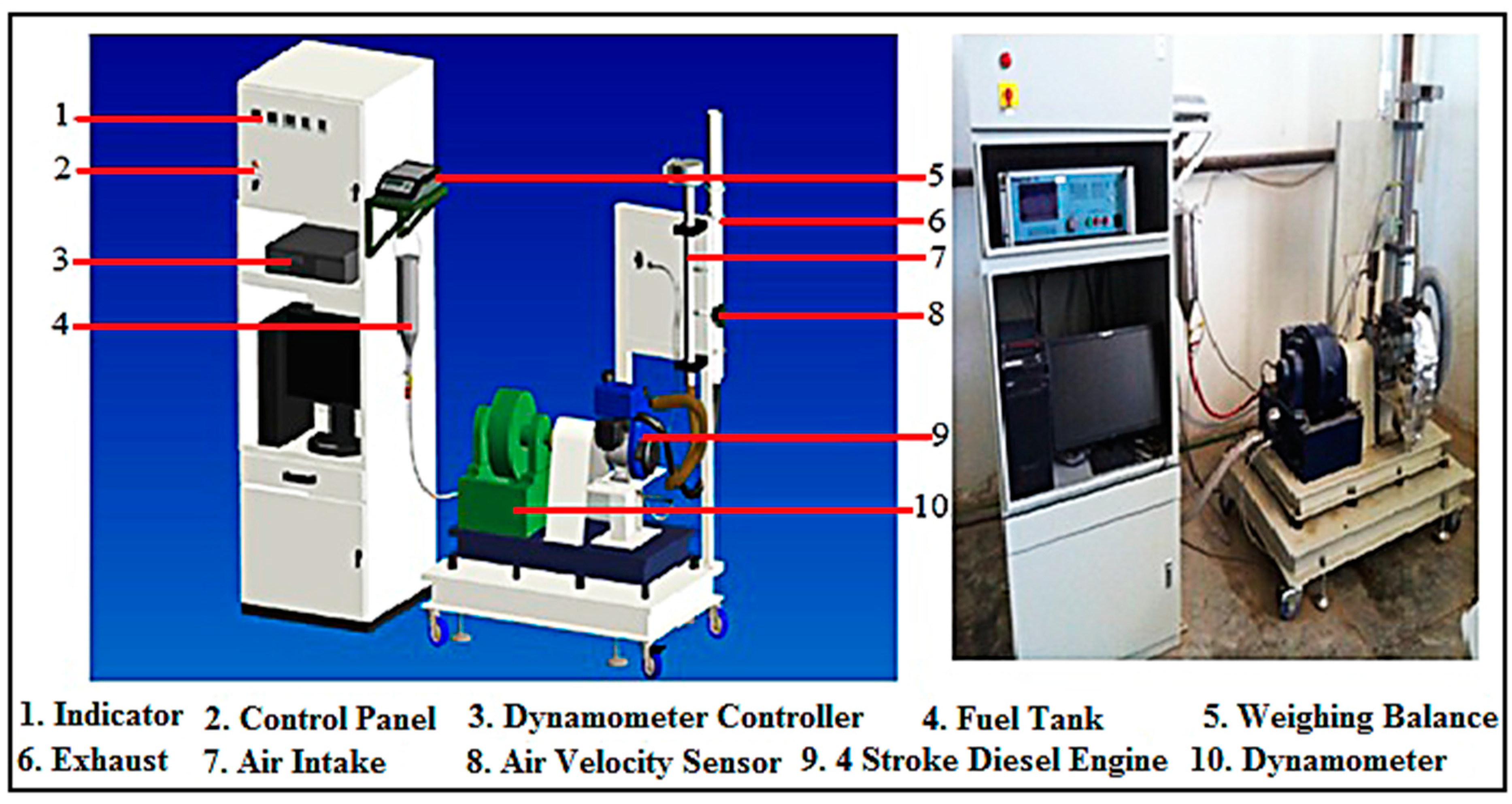


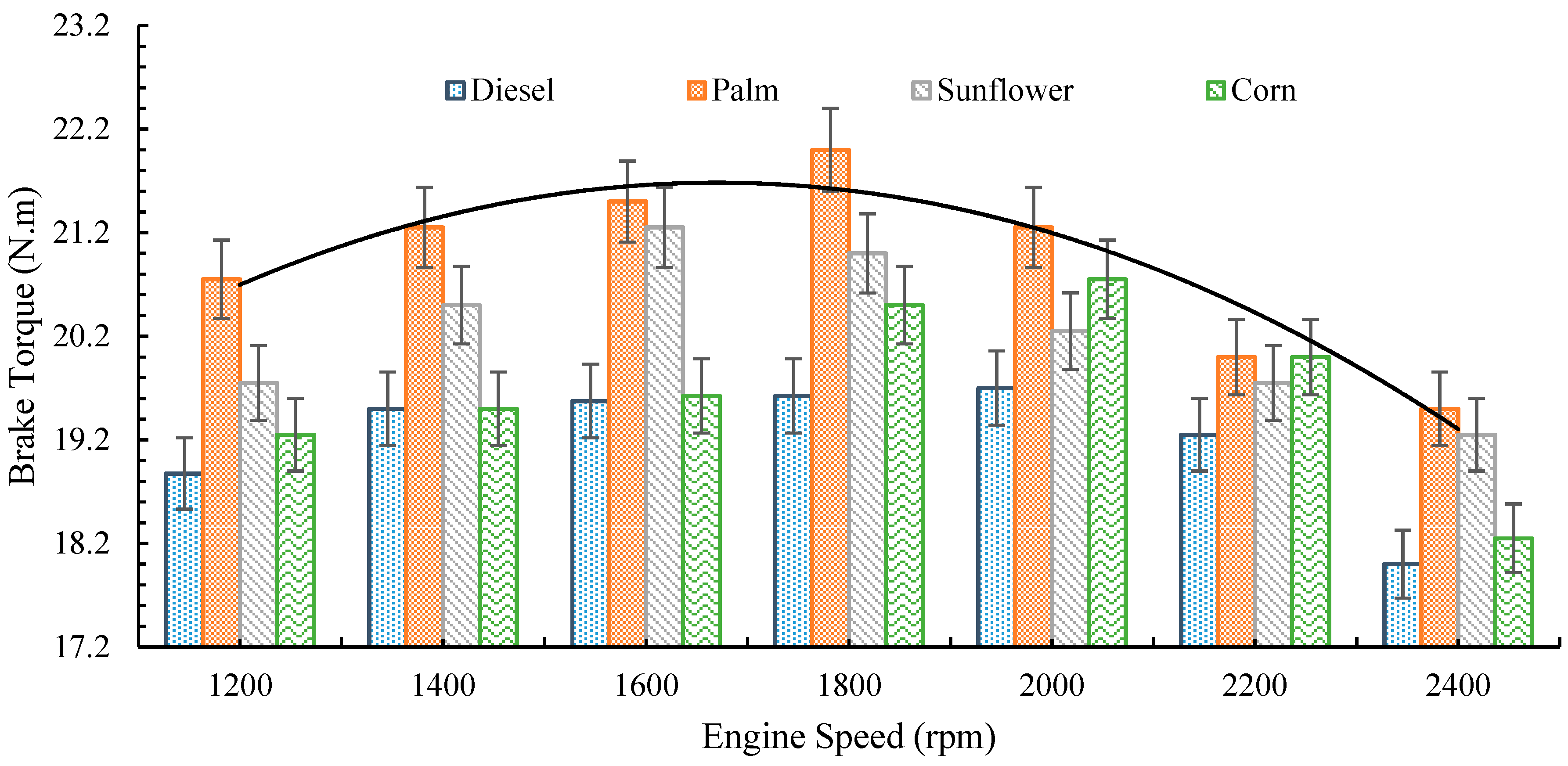
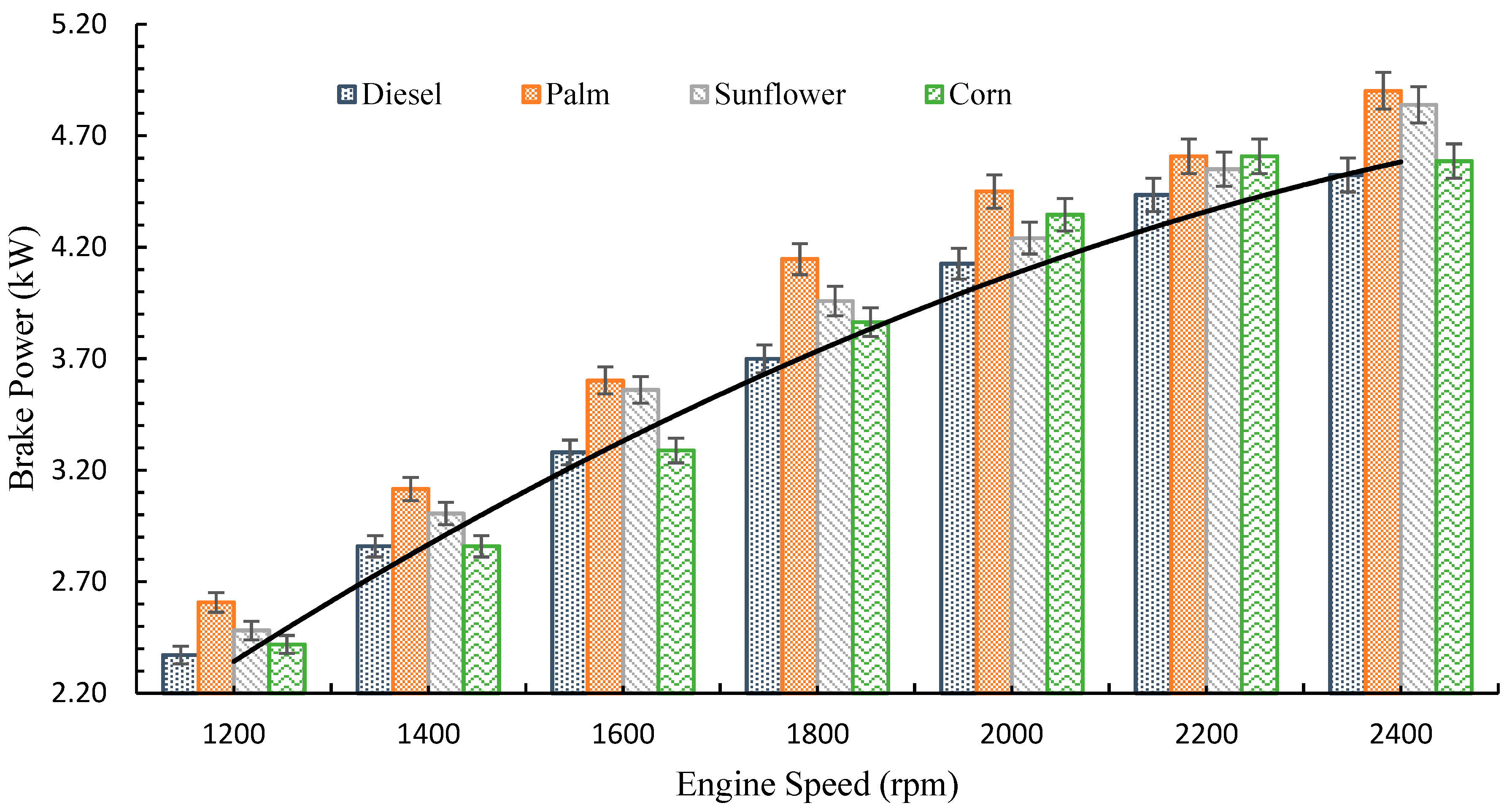
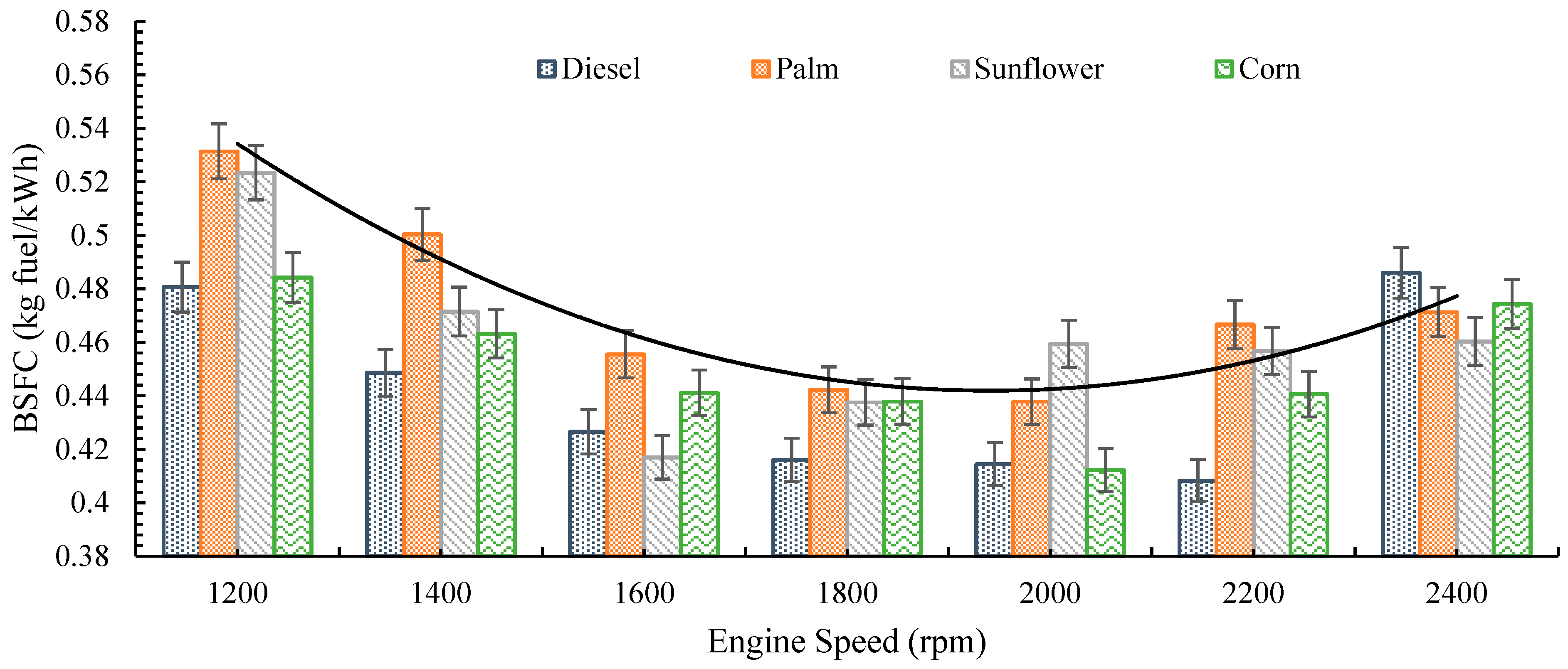
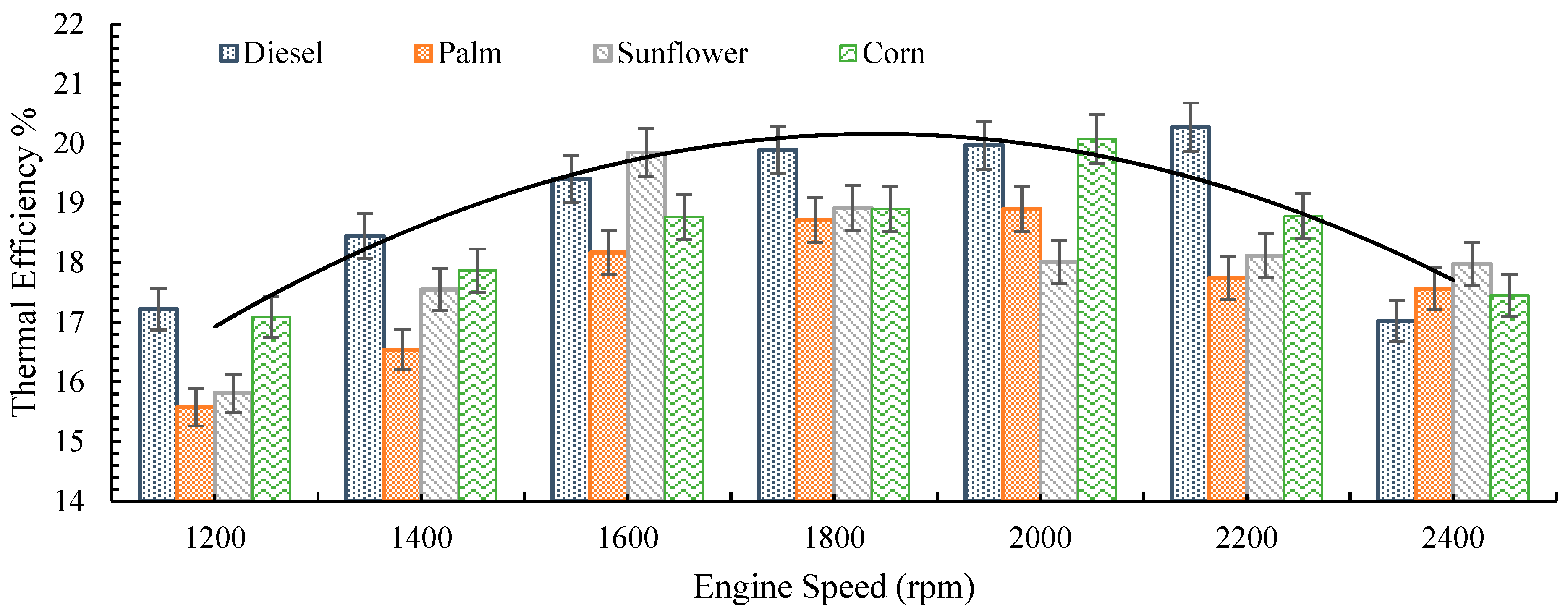

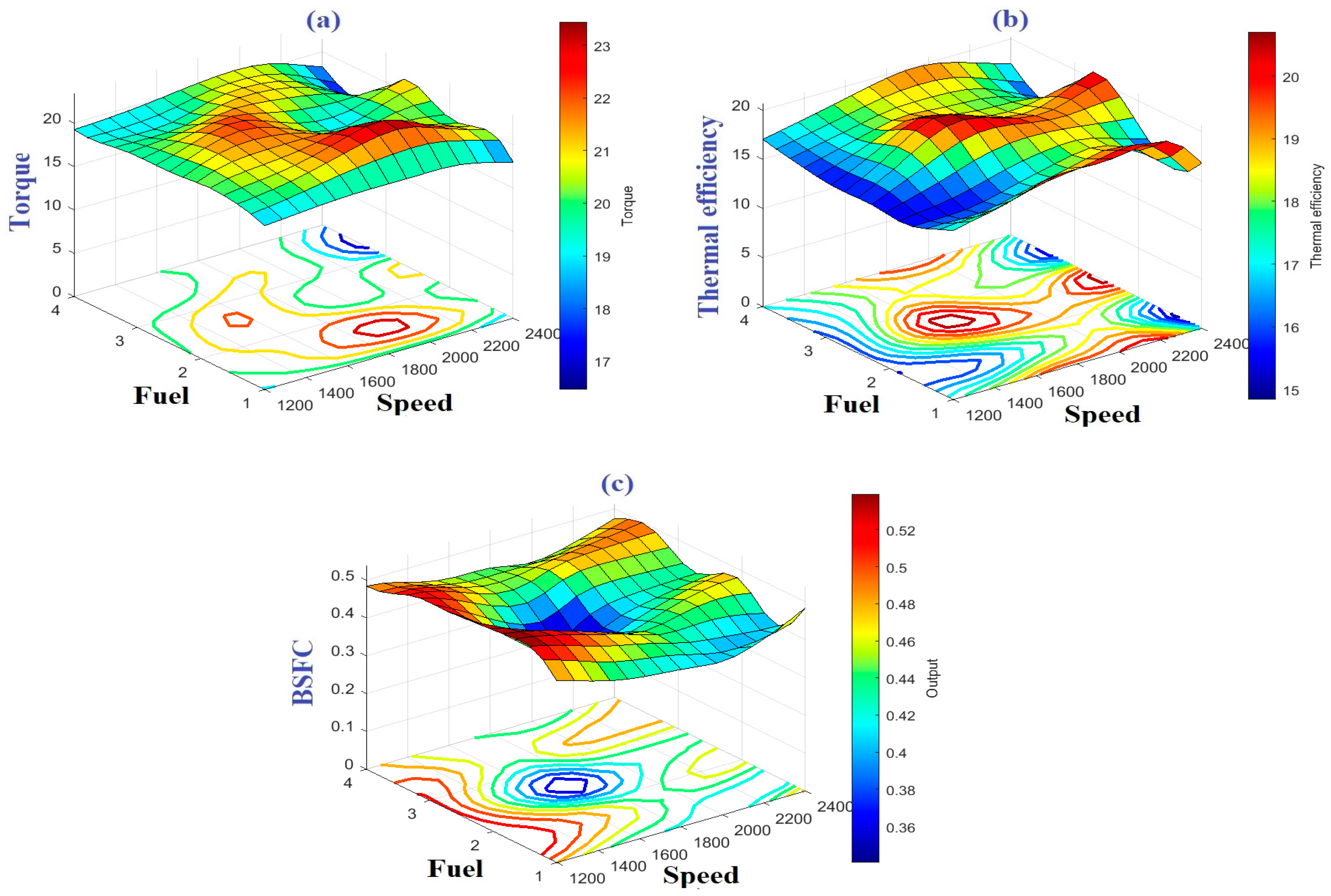
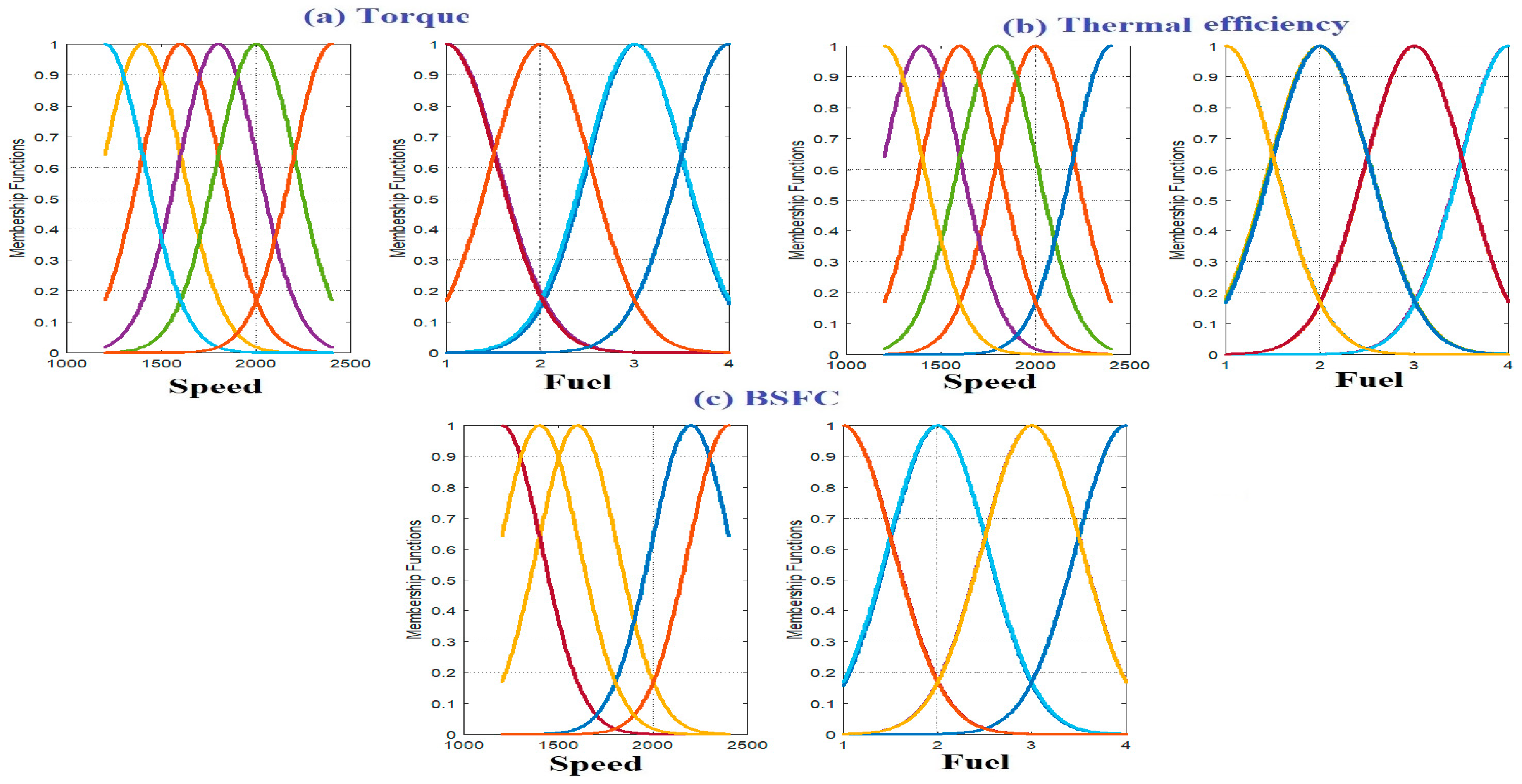
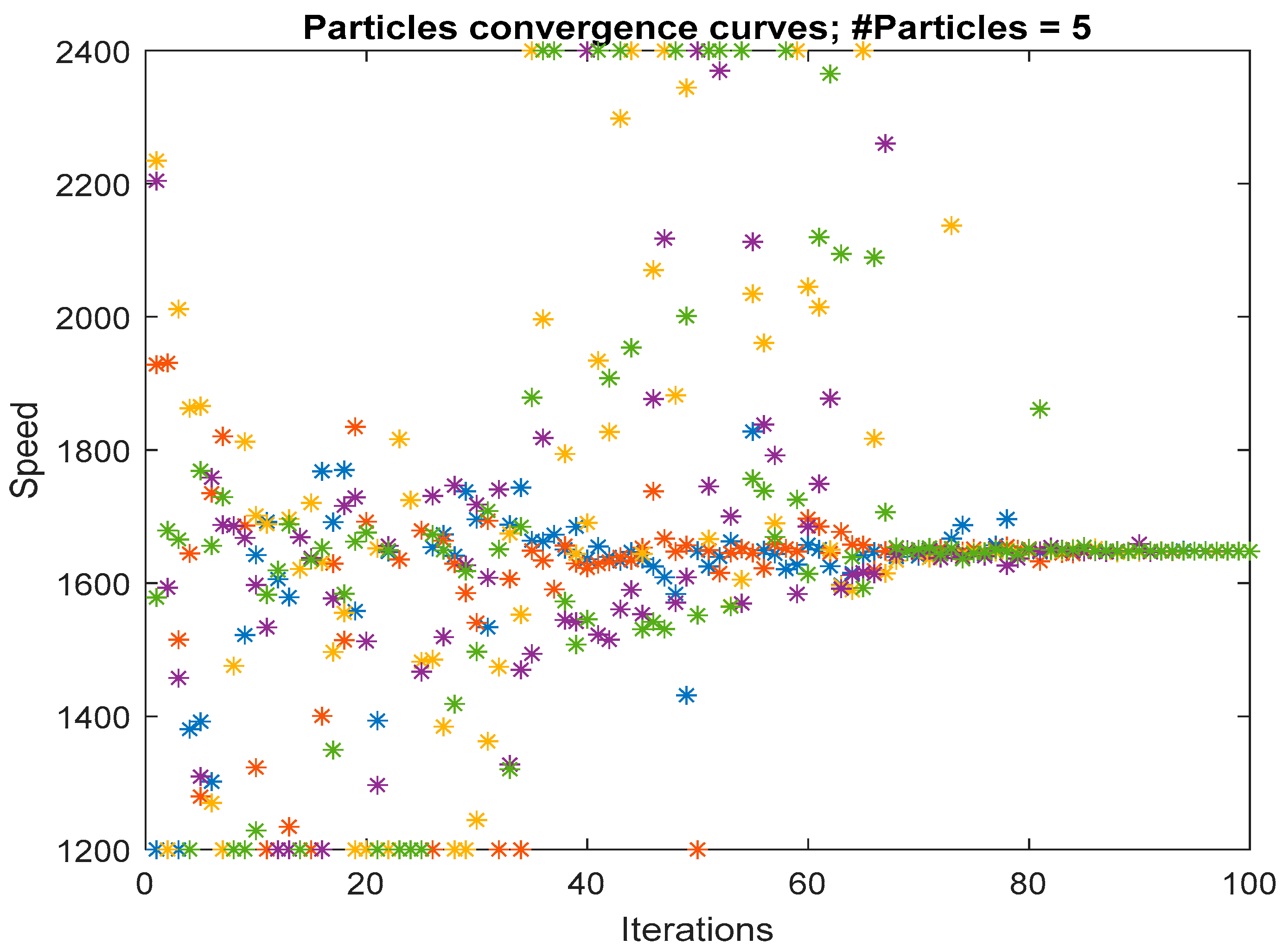
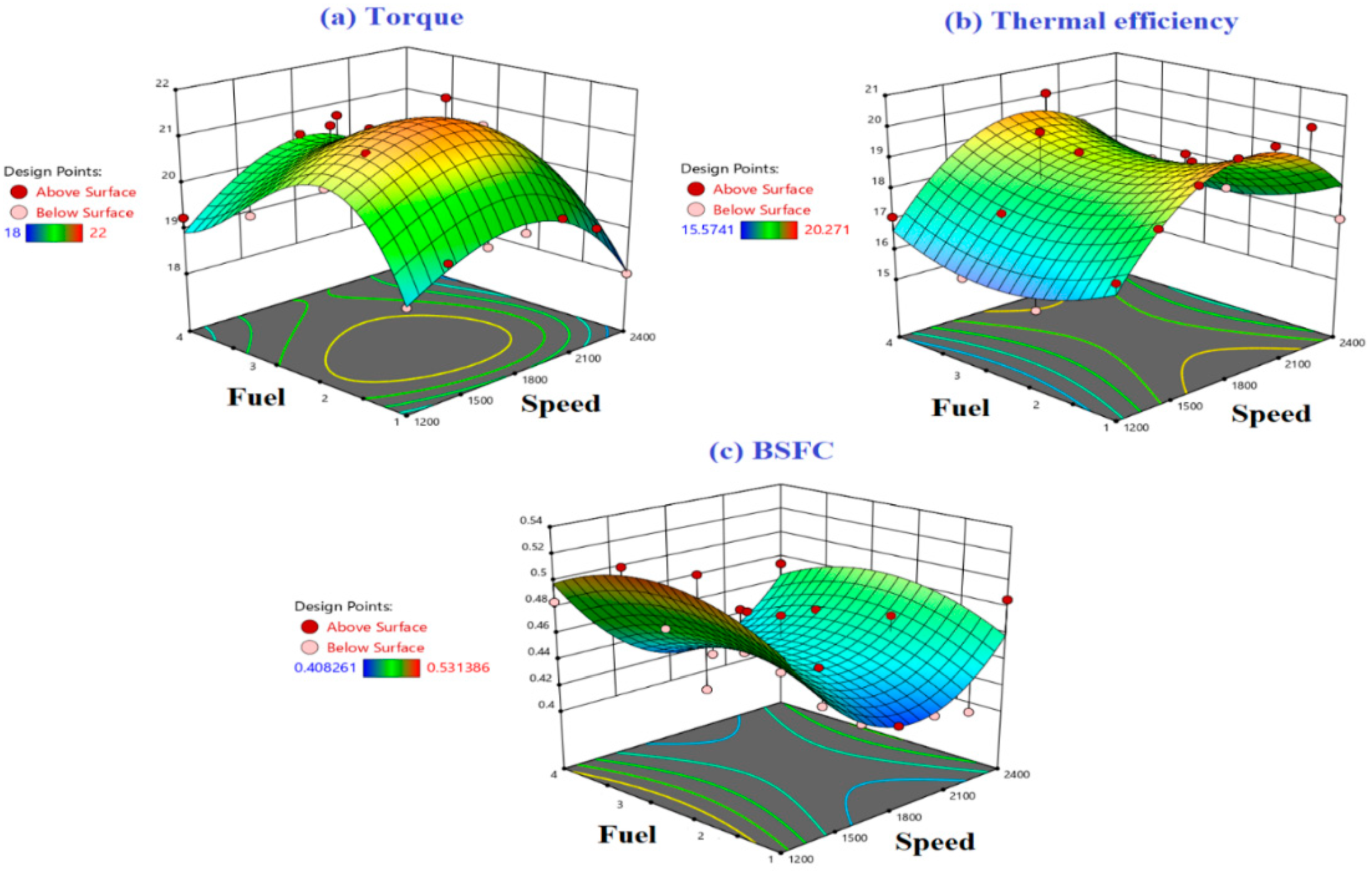
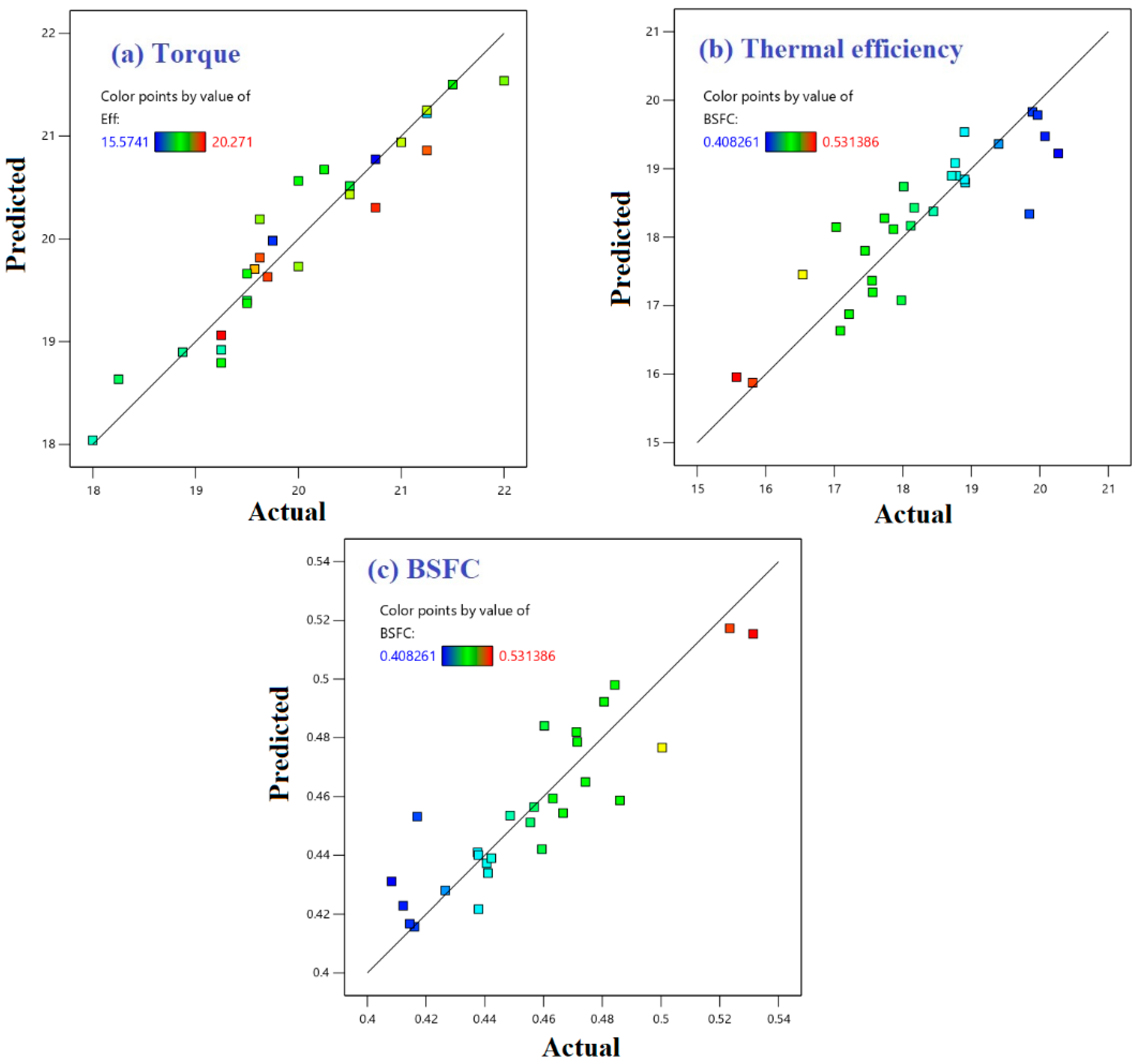
| Technical Data | Specification |
|---|---|
| Type | Lister LV1 |
| Maximum Power | 9 HP (6.7 kW) @ 3000 rpm |
| Maximum torque | 25 Nm @ 2000 rpm |
| Number of cylinders | Single |
| Engine Operation | Four Stroke |
| Nominal speed range | 1000–3000 rpm |
| Bore ∗ Stroke | 85.73 × 82.55 mm |
| Compression ratio | 0.70902778 |
| Connecting rod length | 188.5 mm |
| Combustion chamber | Direct injection |
| Piston shape | Bowl-in-piston |
| Orifice diameter of the nozzle | 0.250 mm |
| Fuel injector holes | 3 |
| Valve number/cylinder | 2 |
| Pressure @ injector opens | 180 bars |
| Intake valve opening/closing | 15⁰ CA BTDC/41⁰ CA ABDC |
| Exhaust valve opening/closing | 41⁰ CA BBDC/15⁰ CA ATDC |
| Dynamometer | Swinging field DC machine with torque measurement by load |
| Technique | Preparation Process | Features | Drawbacks |
|---|---|---|---|
| Transesterification | Alcohol (methanol or ethanol) and catalyst were used to react the vegetable/animal oils. Following that, the combination of glycerol and methyl/ethyl esters (biodiesel) will be separated and purified before being used. | Relatively low cost with a high conversion, moderate processing settings, product qualities comparable to diesel and large-scale manufacturing | Low levels of water and free fatty acids in the raw resources were required, as well as lengthy separation and purification stages, the possibility of side reactions, and the formation of a substantial volume of effluent. |
| Blending | Pre-heated vegetable/animal oils were mixed with diesel in a 10–40% (w/w) ratio. The diesel engine was then coupled with the oil-diesel mixture. | There is no need for a chemical process (it is non-polluting), no technical adjustments, and it is simple to apply. | Inadequate spraying behaviour, weak atomization, improper fuel combustion, and difficulties in fueling by conventional engines caused by the high viscosity, unreliable, low volatility, and rise in vegetable/animal oil component. |
| Microemulsification | The vegetable/animal oils were dissolved in an alcohol-based solvent and a surfactant until they reached the desired viscosity. | Simple method that does not pollute the environment. | High viscosity, limited stability, and the possibility of sticking, incomplete combustion, and carbon deposition. |
| Pyrolysis | The vegetable/animal oils were preheated to a high temperature, usually exceeding 350 degrees Celsius, and then decomposed. It did not matter if the catalyst was there or not. Several products were examined depends on the individual product’s boiling temperature range. | Practical technique, easy (no washing, drying, or filtration is necessary), waste, and pollution-free. | High temperatures and costly equipment are required, and the biodiesel produced is of low purity |
| Sources | % (wt) Palmitic (C16:0) | % (wt) Stearic (C18:0) | % (wt) Oleic (C18:1) | % (wt) Linoleic (C18:2) | % (wt) Linolenic (C18:3) |
|---|---|---|---|---|---|
| Palm oil | 45 | 4 | 39 | 11 | - * |
| Sunflower | 3–10 | 1–10 | 14–35 | 55–75 | <0.3 |
| Corn | 8–10 | 1–4 | 30–50 | 3456 | 0.5–1.5 |
| Properties | Diesel | Corn Biodiesel | Palm Biodiesel | Sunflower Biodiesel | Test method | Equipment | Accuracy | Error |
|---|---|---|---|---|---|---|---|---|
| Cetane Number | 47 | 53 | 61 | 52 | ASTM D613 | - | - | |
| Flash Point, °C | 52 | 74.74 | 72 | 86 | ASTM D-93 | Point-automatic NPM 440 (Norma Lab, France) | - | - |
| Iodine Value (cg I/g oil) | - | 103–140 | 35–61 | 110–143 | ASTM D5554-15 | FTIR spectroscopy | - | - |
| Saponification Number | - | 202 | 186–209 | 200 | ASTM D5558-95 | FTIR spectroscopy | - | - |
| Pour point, °C | −32 | −18 | −10 | −5.0 | ASTM D97 | Cloud And Pour Point Apparatus | - | - |
| Cloud point, °C | −18 | −15 | −5 | 4.0 | ASTM D2500 | Cloud And Pour Point Apparatus | - | - |
| Specific gravity@ 15 °C | 0.83 | 0.855 | 0.85 | 0.853 | IP 190/93 | Capillary stoppered Pycnometer | ±10−3 g/cm3 | ±0.12% |
| Viscosity at 40 °C (cSt) | 3.85 | 4.772 | 5.281 | 4.963 | ASTM D445 | EMILA rotary viscometer apparatus | ±0.1 cP | ±2.6% |
| Heating Value (MJ/kg) | 43.5 | 39.5 | 40.1 | 39.8 | ASTM D240 | automated adiabatic bomb calorimeter | ±0.04 MJ/kg | ±0.1% |
| Reference | Engine Type | Fuel | Test Conditions | BP | BSFC | BTE |
|---|---|---|---|---|---|---|
| Ozsezen et al. [98] | Six cylinders | Palm | Constant speed @ 1500 rpm, variable load | Reduced 2.5% | Increased 7.5% | Reduced 0.48% |
| Dulger and Kaplan [99] | Four cylinders | Sunflower | Variable speed @ Full load | Reduced 10% | Increased 2–5% | - |
| Fayad et al. [86] | Four cylinders | Sunflower | Variable speed @ Full load | - | Increased 23–35.7 | Reduced 27%–30.4% |
| Lin et al. [100] | Single cylinder | Corn oil methyl ester | Variable speed and variable load | Increased 0.4% | Increased 10% | - |
| Palm oil methyl ester | Increased 1.5 | Increased 14.4% | - | |||
| Ndayishimiye and Tazerout [39] | Single cylinder | Palm | Constant speed @ 1500 rpm, variable load | - | 10% Increased | Reduced 1–2% |
| Canakci et al. [101] | Four cylinder | Palm | Variable speed @Full load | Reduced 0–7% | 11% Increased | Reduced 8% |
| Suryanarayanan et al. [102] | Single cylinder | Sunflower | Constant speed @ 1500 rpm, variable load | - | Increased 6–12% | Increased 2–5% |
| Reddy et al. [103] | Single cylinder | Corn seed | Constant speed @ 1500 rpm, variable load | - | 8% Increased | Reduced 3.2% |
| Current Study | Single cylinder | Palm | Variable speed @Full load | Increased 8.7% | Increased 7.4% | Reduced 6.7% |
| Sunflower | Increased 5.4% | Increased 4.9% | Reduced 4.4% | |||
| Corn | Increased 2.5% | Increased 2.5% | Reduced 2.4% |
| MSE | Coefficient of Determination (R2) | ||||
|---|---|---|---|---|---|
| Train | Test | All | Train | Test | All |
| First fuzzy model of brake Torque | |||||
| 6.71 × 10−6 | 0.0805 | 0.0259 | 1 | 0.9145 | 0.9713 |
| Second fuzzy model of thermal efficiency | |||||
| 5.99 × 10−8 | 0.1736 | 0.0558 | 1 | 0.845 | 0.9626 |
| Third fuzzy model of BSFC | |||||
| 1.53 × 10−7 | 0.0002 | 0.0001 | 0.9998 | 0.7845 | 0.9408 |
| Average | |||||
| 2.31 × 10−6 | 8.48 × 10−2 | 2.73 × 10−2 | 1 | 0.84801 | 0.9581 |
| Study Type | Response Surface | Subtype | Randomized |
|---|---|---|---|
| Design Type | Central Composite | Runs | 28.00 |
| Design Model | Quadratic | Blocks | No Blocks |
| Source | Sum of Squares | df | Mean Square | F-Value | p-Value | |
|---|---|---|---|---|---|---|
| Model | 22.88 | 9 | 2.54 | 20.93 | <0.0001 | significant |
| S (speed) | 0.1552 | 1 | 0.1552 | 1.28 | 0.2731 | |
| F (fuel) | 1.22 | 1 | 1.22 | 10.02 | 0.0054 | |
| SF | 0.1407 | 1 | 0.1407 | 1.16 | 0.2961 | |
| S² | 9.36 | 1 | 9.36 | 77.06 | <0.0001 | |
| F² | 8.69 | 1 | 8.69 | 71.57 | <0.0001 | |
| S²F | 0.0540 | 1 | 0.0540 | 0.4447 | 0.5133 | |
| SF² | 0.3919 | 1 | 0.3919 | 3.23 | 0.0892 | |
| S³ | 0.1465 | 1 | 0.1465 | 1.21 | 0.2866 | |
| F³ | 2.03 | 1 | 2.03 | 16.70 | 0.0007 | |
| Residual | 2.19 | 18 | 0.1214 | |||
| Cor Total | 25.06 | 27 |
| Source | Sum of Squares | df | Mean Square | F-Value | p-Value | |
|---|---|---|---|---|---|---|
| Model | 32.15 | 5 | 6.43 | 15.77 | <0.0001 | significant |
| S | 4.62 | 1 | 4.62 | 11.33 | 0.0028 | |
| F | 0.3366 | 1 | 0.3366 | 0.8254 | 0.3735 | |
| SF | 0.0044 | 1 | 0.0044 | 0.0109 | 0.9178 | |
| S2 | 22.28 | 1 | 22.28 | 54.64 | <0.0001 | |
| F2 | 4.90 | 1 | 4.90 | 12.03 | 0.0022 | |
| Residual | 8.97 | 22 | 0.4078 | |||
| Cor Total | 41.12 | 27 |
| Source | Sum of Squares | df | Mean Square | F-Value | p-Value | |
|---|---|---|---|---|---|---|
| Model | 0.0216 | 5 | 0.0043 | 17.07 | <0.0001 | significant |
| S | 0.0035 | 1 | 0.0035 | 13.70 | 0.0012 | |
| F | 0.0001 | 1 | 0.0001 | 0.5526 | 0.4651 | |
| SF | 1.240 × 10−7 | 1 | 1.240 × 10−7 | 0.0005 | 0.9825 | |
| S2 | 0.0148 | 1 | 0.0148 | 58.62 | <0.0001 | |
| F2 | 0.0031 | 1 | 0.0031 | 12.47 | 0.0019 | |
| Residual | 0.0056 | 22 | ||||
| Cor Total | 0.0271 | 27 |
| First ANOVA Model of Brake Torque | |||
|---|---|---|---|
| Std. Dev. | 0.3485 | R2 | 0.9128 |
| Mean | 20.01 | Adjusted R2 | 0.8692 |
| C.V.% | 1.74 | Predicted R2 | 0.7278 |
| Adeq Precision | 16.7946 | ||
| Second ANOVA Model of Rz | |||
| Std. Dev. | 0.6386 | R2 | 0.7818 |
| Mean | 18.24 | Adjusted R2 | 0.7322 |
| C.V.% | 3.50 | Predicted R2 | 0.6130 |
| Adeq Precision | 13.368 | ||
| Third ANOVA Model of BSFC | |||
| Std. Dev. | 0.0159 | R2 | 0.7951 |
| Mean | 0.4559 | Adjusted R2 | 0.7485 |
| C.V.% | 3.49 | Predicted R2 | 0.6274 |
| Adeq Precision | 13.8074 | ||
| Oil Type | Speed (rpm) | Torque (N.m) | Change (%) | Efficiency (%) | Change (%) | BSFC (kgf/kWh) | Change (%) | Overall (%) |
|---|---|---|---|---|---|---|---|---|
| Diesel | 1841.06 | 19.8057 | 0.0 | 19.8637 | 0.0 | 0.415 | 0.0 | 0.0 |
| Palm Oil | 1845.55 | 21.5087 | +8.599 | 18.9295 | −4.703 | 0.438 | −5.542 | −1.647 |
| Sunflower | 1844.47 | 20.9137 | +5.594 | 18.8297 | −5.205 | 0.44 | −6.024 | −5.635 |
| Corn | 1862.71 | 20.4353 | +3.179 | 19.5726 | −1.465 | 0.421 | −1.446 | 0.268 |
| Method | Fuel Type | Speed (rpm) | Torque (N.m) | Change (%) | Efficiency (%) | Change (%) | BSFC (kgf/kWh) | Change (%) | Overall (%) |
|---|---|---|---|---|---|---|---|---|---|
| Experimental | Sunflower Oil | 1600 | 21.25 | 0.0 | 19.848 | 0.0 | 0.4169 | 0.0 | 0.00 |
| RSM | Corn Oil | 1862.71 | 20.4353 | −3.834 | 19.5726 | −1.388 | 0.421 | −0.969 | −6.191 |
| Proposed | Sunflower Oil | 1648 | 21.482 | 1.092 | 19.71 | −0.696 | 0.41 | 1.669 | 2.065 |
Publisher’s Note: MDPI stays neutral with regard to jurisdictional claims in published maps and institutional affiliations. |
© 2022 by the authors. Licensee MDPI, Basel, Switzerland. This article is an open access article distributed under the terms and conditions of the Creative Commons Attribution (CC BY) license (https://creativecommons.org/licenses/by/4.0/).
Share and Cite
Alahmer, A.; Rezk, H.; Aladayleh, W.; Mostafa, A.O.; Abu-Zaid, M.; Alahmer, H.; Gomaa, M.R.; Alhussan, A.A.; Ghoniem, R.M. Modeling and Optimization of a Compression Ignition Engine Fueled with Biodiesel Blends for Performance Improvement. Mathematics 2022, 10, 420. https://doi.org/10.3390/math10030420
Alahmer A, Rezk H, Aladayleh W, Mostafa AO, Abu-Zaid M, Alahmer H, Gomaa MR, Alhussan AA, Ghoniem RM. Modeling and Optimization of a Compression Ignition Engine Fueled with Biodiesel Blends for Performance Improvement. Mathematics. 2022; 10(3):420. https://doi.org/10.3390/math10030420
Chicago/Turabian StyleAlahmer, Ali, Hegazy Rezk, Wail Aladayleh, Ahmad O. Mostafa, Mahmoud Abu-Zaid, Hussein Alahmer, Mohamed R. Gomaa, Amel A. Alhussan, and Rania M. Ghoniem. 2022. "Modeling and Optimization of a Compression Ignition Engine Fueled with Biodiesel Blends for Performance Improvement" Mathematics 10, no. 3: 420. https://doi.org/10.3390/math10030420
APA StyleAlahmer, A., Rezk, H., Aladayleh, W., Mostafa, A. O., Abu-Zaid, M., Alahmer, H., Gomaa, M. R., Alhussan, A. A., & Ghoniem, R. M. (2022). Modeling and Optimization of a Compression Ignition Engine Fueled with Biodiesel Blends for Performance Improvement. Mathematics, 10(3), 420. https://doi.org/10.3390/math10030420










